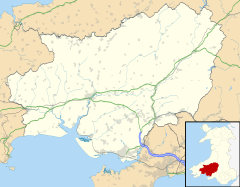Brynamman
Brynamman
|
|
|---|---|
| Brynamman shown within Carmarthenshire | |
| Community | |
| Principal area | |
| Ceremonial county | |
| Country | Wales |
| Sovereign state | United Kingdom |
| Post town | AMMANFORD |
| Postcode district | SA18 |
| Dialling code | 01269 |
| Police | Dyfed-Powys |
| Fire | Mid and West Wales |
| Ambulance | Welsh |
| EU Parliament | Wales |
| UK Parliament | |
| Welsh Assembly | |
Brynamman (Welsh: Brynaman) is a village sitting on the south facing side of the Black Mountain (Y Mynydd Du), part of the Brecon Beacons National Park (Parc Cenedlaethol Bannau Brycheiniog). The village is split in two into Upper Brynamman and Lower Brynamman by the River Amman which also acts as the boundary between the counties of Carmarthenshire and Neath Port Talbot (the old county of Glamorganshire). Ruins of stone dwellings (possibly prehistoric), an early type of lime kiln and rectangular medieval buildings found on the mountain show that man has lived in this area for a long time.
In the 18th century the industrial revolution, in the form of iron and tin works and especially coal mining, transformed the area from a small, scattered farming community to a built-up, highly populated commercial centre. The Welsh language was at the fore and the successful participation in local and national eisteddfodau by numerous village people, choirs and bands put Brynamman on the map.
It was once a thriving village, with three bank branches on Station Road in Upper Brynamman alone. Today there are no industries in or around the village, its inhabitants having to commute to Ammanford, Swansea or Llanelli for work. The whole area has become more attractive to live in especially for those who love the countryside and the wild open areas available for walking on the Black Mountain (Y Mynydd Du). It is still a stronghold for the Welsh language and children are taught it in school and it is spoken by a high majority of the local people.
Brynamman was previously known as Y Gwter Fawr (Welsh: "The Big Gutter"), the name was changed when the railway from Ammanford reached the village. The traveller and writer George Borrow describes aspects of Gwter Fawr in the mid-nineteenth century in his book Wild Wales which was published in 1862.
...
Wikipedia

